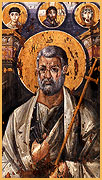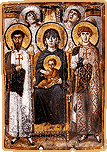|
The religious painting
What little has survived of Early Byzantine monumental
painting, comes  mainly
from funerary monuments, such as catacombs, or from churches
in marginal areas where climatic conditions favoured the preservation
of the medium. The former category of monuments shows a variety
of abbreviated religious representations and symbols in a
naturalistic style largely dependent on pagan imagery. The
latter category is best illustrated by the wall paintings
of Bawit and Saqqara in Egypt, which exemplify the rich provincial
style of Coptic art. mainly
from funerary monuments, such as catacombs, or from churches
in marginal areas where climatic conditions favoured the preservation
of the medium. The former category of monuments shows a variety
of abbreviated religious representations and symbols in a
naturalistic style largely dependent on pagan imagery. The
latter category is best illustrated by the wall paintings
of Bawit and Saqqara in Egypt, which exemplify the rich provincial
style of Coptic art.
More typical of the Early Byzantine metropolitan style
are the portable icons. These are panels of wood painted in
encaustic, a method in which pigments are mixed with wax.
Icons with portrait busts or standing figures of Christ, the
Virgin and Child, saints, prophets, and archangels, were important
in both public and private worship. Some were credited to
have prophylactic and healing powers, or to have been miraculously
created. The iconoclast reaction of the eighth-ninth centuries
resulted in the  destruction
of a great number of them, but several
pre-iconoclast
examples
have been preserved in the remote monastery of St Catherine
on Mount Sinai, where they were brought by pilgrim visitors
from around the empire or sent as gifts from the capital (the
monastery being an imperial foundation). The Sinai icons of
St Peter and the Virgin enthroned have been attributed to
Constantinople because of their classical conception and high
quality. The former icon shows a naturalistic portrait of
the saint, placed against a niched wall bellow three bust-medallions
representing Christ, the Virgin and St John the Evangelist.
The type may have developed from the pagan Roman custom of
placing portraits in funerary contexts; similar portraits
are known from the burials of Roman colonists at Fayoum, Egypt.
The second icon pictures a solid three-dimentional Virgin
and Child in a similar architectural setting, enthroned between
two saints (possibly Theodore and George) and two angels.
The static frontality of the saints contrasts with the averted
gaze of the Virgin and the Child or the sharp mouvement of
the angels glancing upwards at the hand of God with its band
of light. The type of the enthroned Virgin (or Christ) also
derives from Roman portraiture, particularly from the representations
of the emperor and other dignitaries. destruction
of a great number of them, but several
pre-iconoclast
examples
have been preserved in the remote monastery of St Catherine
on Mount Sinai, where they were brought by pilgrim visitors
from around the empire or sent as gifts from the capital (the
monastery being an imperial foundation). The Sinai icons of
St Peter and the Virgin enthroned have been attributed to
Constantinople because of their classical conception and high
quality. The former icon shows a naturalistic portrait of
the saint, placed against a niched wall bellow three bust-medallions
representing Christ, the Virgin and St John the Evangelist.
The type may have developed from the pagan Roman custom of
placing portraits in funerary contexts; similar portraits
are known from the burials of Roman colonists at Fayoum, Egypt.
The second icon pictures a solid three-dimentional Virgin
and Child in a similar architectural setting, enthroned between
two saints (possibly Theodore and George) and two angels.
The static frontality of the saints contrasts with the averted
gaze of the Virgin and the Child or the sharp mouvement of
the angels glancing upwards at the hand of God with its band
of light. The type of the enthroned Virgin (or Christ) also
derives from Roman portraiture, particularly from the representations
of the emperor and other dignitaries.
|